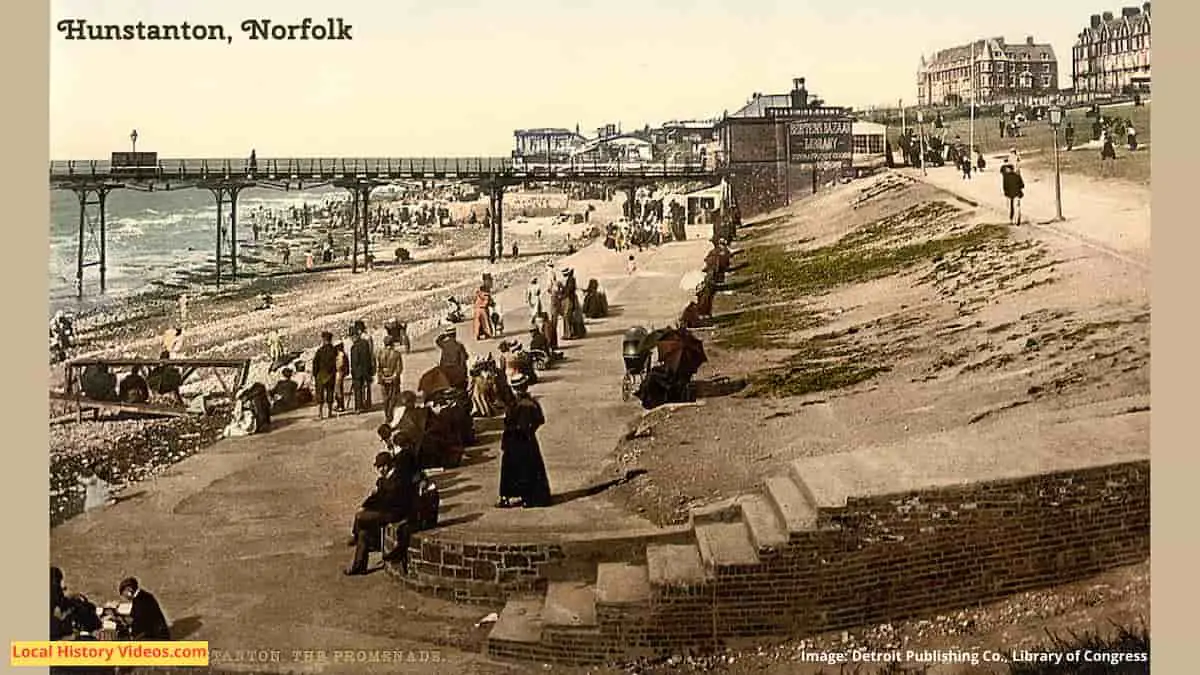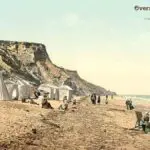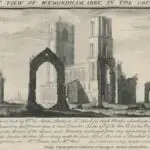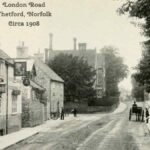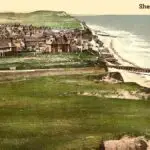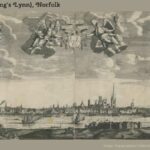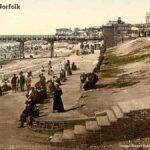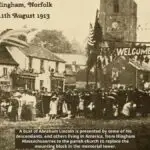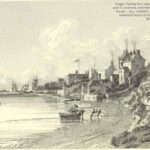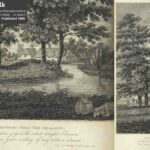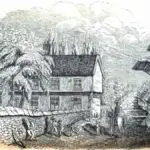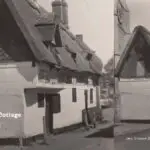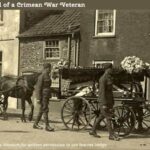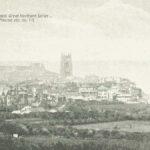Glimpse history through old images of Hunstanton, Norfolk, England.
Women’s Golf (1928)
In 1928, a young French woman, 21 year-old mademoiselle Manette le Blan, won the Women’s Open Golf Championship at Hunstanton, which was not her first win.
Women’s Open Golf Championship (1928) – British Pathé on YouTube
Lavender Picking (1948)
In the late 1940s, 100 acres of lavender fields were harvested by young women, whose earnings were paid according to how much they picked.
Then the lavender was sent a distilling plant, where men loaded the crop into steaming vats, so it could be distilled into lavender oil.
British perfumes had originally required French oils, but the newsreel states this caused a crisis for the industry 15 years ago – presumably because World War II caused supply issues – and a British perfumier had struck upon the idea of using British lavender oil.
Lavender Harvest (1948) – British Pathé on YouTube
Flooding (1949)
Black and white footage from 1949 shows a number of locations the region affected by severe flooding, including Snettisham, Skegness, Hunstanton and Heacham.
Floods In Eastern England (1949) – British Pathé on YouTube
Storm Damage (1950s)
Silent, black and white footage recorded in the 1950s shows the damage and flooding caused by gale force winds, which damaged the sea defences.
Rescue workers, including US airmen, also appear.
Gale Disaster At Hunstanton (1950-1959) – British Pathé on YouTube
Lavender Harvest (1958)
Hunstanton’s lavender picking and oil production hasn’t changed much from the newsreel 10 years earlier, except the footage is now in colour, the women’s clothing is different, and very young children held with the harvesting.
It takes a vat of lavender, weighing about a quarter of a tonne, to produce 30-40 ounces of pure oil.
Lavender Harvest (1958) – British Pathé on YouTube
A bit of Hunstanton history
Extract from: “Hunstanton and Its Neighbourhood: Being a Guide to the Lynn and Hunstanton Railway Line”, by Philip WILSON (of Lynn Regis.) and George H. Webster
Published in 1873
Pages 29 – 30
We have now arrived at the north – east point of Norfolk, upon which stands the pleasant village of Hunstanton, on an eminence, with a declivity to the east, opening into a fine valley, and terminated on the north – west by a lofty cliff called the Gore, or St. Edmund’s point, being distant 10 miles west of Burnham Market, and 17 miles north by east of Lynn, commanding an extensive view of the ocean, and having a firm sandy beach.
The population in 1861 was 490; since then it has been steadily increasing, and at the census in 1871 amounted to about 810.
Its rate of mortality is exceedingly low. The deaths in 25 years ending June, 1862, gave an average of only 13-9 in 1000, thus placing the village in the highest position in the kingdom in point of salubrity.
The beautiful scenery in its vicinity has for many years past made Hunstanton a favourite watering place; and it would unquestionably have been, long before, a place of great resort for that purpose, had sufficient accommodation been provided. Year after year every house, and even every cottage that could be made available as a lodging – house, has been occupied by visitors.
Excellent houses of different sizes and a handsome and commodious hotel have now been erected on the cliff just above the rail way station, and there is every probability that in a few years the influx of visitors will create a demand for terraces of buildings, which will rival those of the most favoured watering places in England.
Pages 33 – 35
Hunstanton church, a fine structure, is situated at the lower end of the village, and has a nave, two aisles and a chancel. During the ages of general neglect of churches, this church was well preserved, and it continues to retain a good condition. The style is Decorated, of an early date. The east window is of very large proportions for the period, and very simple in design, consisting merely of plain circles above the lights. The west window being dilapidated, one in the Perpendicular style, ill agreeing with the general structure of the church, was inserted about 50 years ago.
In the year 1860 the late Mr. L’Estrange undertook the entire repair and restoration of the fabric, and added the clerestory over the arches of the aisles, substituting at the same time for the west window above referred to a new one of beautiful design in the style of the church. The new roof is extremely costly and elaborate; the solid beams of oak and the lofty pitch and singular beauty of its massive form are well worthy the attention of the architect and visitor. The whole of the timber was given by Mr. L’Estrange off the Hunstanton estate; and the entire restoration was completed from designs by that accomplished gentleman, the work being carried out by masons and carpenters under his immediate supervision.
In the centre of the chancel stood, until the recent alterations, what Blomefield calls a most noble and beautiful altar monument of marble to Roger L’Estrange, knight of the body to Henry VII., but it has now been removed. This tomb is curiously ornamented with brass, and the portraiture of a knight in complete armour, having on his surtout the arms of L’Estrange quartering Vernon, Camois, Walkware, Morieux, Pike, Rushbrook, & c.; with his crest on his helmet, -a lion passant guardant; over his head have been two brass shields with the arms of L’Estrange impaling Heydon, one of which still remains; and at his feet two, one of which is now remaining, – quarterly L’Estrange and Morieux; also one on each side of him, now reaved. On the foot of the monument are the words “Remembrez a moy, remembyr L’Estrange. “On a fillet of brass round the edge of the stone “Orate pro a’i’a. “In the north wall is inserted a monument, under a lofty canopy of stone work finely carved, to Henry L’Estrange and Katherine his wife, of the date 25th November, 1485; and on a marble grave – stone will be found the following quaint inscription:
“Hamo Extraneus, miles, obt. 31 Maij, 1654, ætat suæ 71. In terris peregrinus eram, nunc incolor cœli.” In heaven, at home, O blessed change ! Who, while I was on earth, was strange.
We will now return to the never – wearying sea; taking the pathway on the margin of the cliff towards the point at which we commenced our peregrination of Hunstanton.
Midway on the summit of the rock, and at about its greatest elevation, is a small and shapeless fragment of ruined walls- being all that remains of the ancient chapel of St. Edmund – said to have been named after Saint Edmund the King, in record of his landing here to assume the crown of East Anglia. The little sanctuary appears to have been desecrated and destroyed ages ago, and little or nothing is known of its architectural character.
Near to this stands, in striking contrast, the glaring white mass of the brand – new looking light – house – a substantial and important building, which, together with the adjoining residences of the light keepers, is (like other properties of the London Trinity board,) kept trim and smart, – almost painfully so, by frequent painting and scouring and unremitting cleanliness.
The gardens adjoining are not very productive, owing to their bleak exposure, and that in the front has been more than once curtailed by the necessity of setting the wall further back in consequence of the destruction of portions of the cliff by the united influences of rain, frost and sea.
The progress of erosion is proceeding at such a rate as to suggest the possible necessity, at no distant date, of pulling down the light – house itself and removing it further inland, or of building a lofty sea – wall for the protection of the cliff at this point.
Either of the two civil and attentive guardians of the light will gladly shew to visitors his collection of sea – shore treasures, fossils, shells and manufactured bijouterie of amber and jet, and will conduct them up the winding way to the lantern, which is of the most improved construction, and on what is called, we believe, the catadioptric principle.
A broad strip of ruby coloured glass, placed vertically from base to summit on the western side of the lantern, will perhaps at first puzzle the inquiring mind; but it will be explained (and practically shewn at dusk) that it throws a ruddy and warning glare upon a dangerous sand in the Wash, known as the “Roaring Middle.” From the light – house, and indeed from any situation on the cliff, may be seen at night, miles out to sea, the regularly returning flash or revolving light of the Lynn Well light ship; whilst in the Lynn roads the Pilot sloop of the local navigation authorities also hoists a lantern for the guidance of seafarers. The channels are carefully buoyed and beaconed, and on the more dangerous sands “life beacons “are erected, for the preservation of those who may have the misfortune to suffer shipwreck. So that altogether the great bay or estuary of the Wash is one of the most carefully tended portions of the navigable waters on our Eastern coast.
More about Norfolk
- Old Images of Norfolk, England
- Old Images of Wymondham, Norfolk
- Old Images of Thetford, Norfolk
- Old Images of Sheringham, Norfolk
- Old Images of King’s Lynn, Norfolk
- Old Images of Hunstanton, Norfolk
- Old Images of Hingham, Norfolk
- Old Images of Gorleston-on-Sea, Norfolk
- Old Images of Fakenham, Norfolk
- Old Images of Diss, Norfolk
- Old Images of Dereham, Norfolk
- Old Images of Overstrand, Norfolk
- Old Images of Attleborough, Norfolk
- Old Images of Holt in Norfolk
- Old Images of Cromer, Norfolk
- Old Images of Norwich, Norfolk
- Old Images of Great Yarmouth, Norfolk
- Norfolk: Local History Resources

